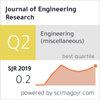Dynamic modeling and ride comfort evaluation of railway vehicle under random track irregularities: A case study of a Linke-Hofmann-Busch coach
IF 0.9
4区 工程技术
Q3 ENGINEERING, MULTIDISCIPLINARY
引用次数: 0
Abstract
The ride comfort of passengers is an important parameter for evaluating the performance of railway vehicles. Many standards/ models, such as quarter car, half car, and full car, have been proposed to evaluate the human comfort of railway vehicles. However, a full-scale coupled railway vehicle model is rarely considered for calculating ride comfort. Therefore, this paper proposes a twenty-seven-degree-of-freedom (27-DOF) coupled dynamic model of railway vehicles integrated with wheel-rail contact forces. The developed model is solved using the two-dimensional (2-D) state space method, and the effects of different track irregularities on human comfort are evaluated. The outputs are described in terms of three-dimensional (3-D) Power Spectral Densities (PSDs) under three types of random track irregularities: vertical profile, lateral alignment, and cross-level. Furthermore, Sperling's method is used to evaluate the human comfort index. For the case study, a Linke-Hofmann-Busch coach (LHB) based model has been employed, and the results are validated with the experimental data of ride comfort reported by the Research Design and Standard Organization (RDSO). The simulated results of the proposed model demonstrate a remarkable alignment with the experimental data, exhibiting a small error ranging from 2.36 % to 8.81 % for vertical motion and 5.84 % to 8.30 % for lateral motion, respectively. Such promising results offer valuable insight for the design of future coaches, ensuring enhanced ride comfort even at high speeds.
随机轨道不平整条件下轨道车辆动力学建模及平顺性评价——以林克-霍夫曼-布施客车为例
本文章由计算机程序翻译,如有差异,请以英文原文为准。
求助全文
约1分钟内获得全文
求助全文
来源期刊

Journal of Engineering Research
ENGINEERING, MULTIDISCIPLINARY-
CiteScore
1.60
自引率
10.00%
发文量
181
审稿时长
20 weeks
期刊介绍:
Journal of Engineering Research (JER) is a international, peer reviewed journal which publishes full length original research papers, reviews, case studies related to all areas of Engineering such as: Civil, Mechanical, Industrial, Electrical, Computer, Chemical, Petroleum, Aerospace, Architectural, Biomedical, Coastal, Environmental, Marine & Ocean, Metallurgical & Materials, software, Surveying, Systems and Manufacturing Engineering. In particular, JER focuses on innovative approaches and methods that contribute to solving the environmental and manufacturing problems, which exist primarily in the Arabian Gulf region and the Middle East countries. Kuwait University used to publish the Journal "Kuwait Journal of Science and Engineering" (ISSN: 1024-8684), which included Science and Engineering articles since 1974. In 2011 the decision was taken to split KJSE into two independent Journals - "Journal of Engineering Research "(JER) and "Kuwait Journal of Science" (KJS).
 求助内容:
求助内容: 应助结果提醒方式:
应助结果提醒方式:


